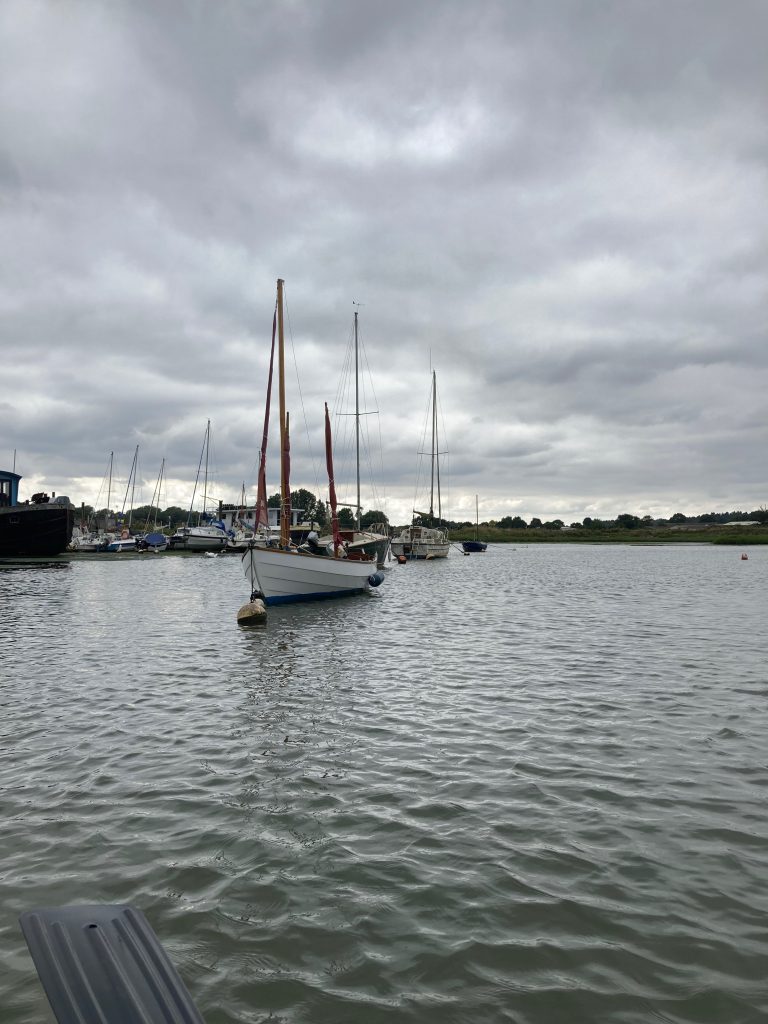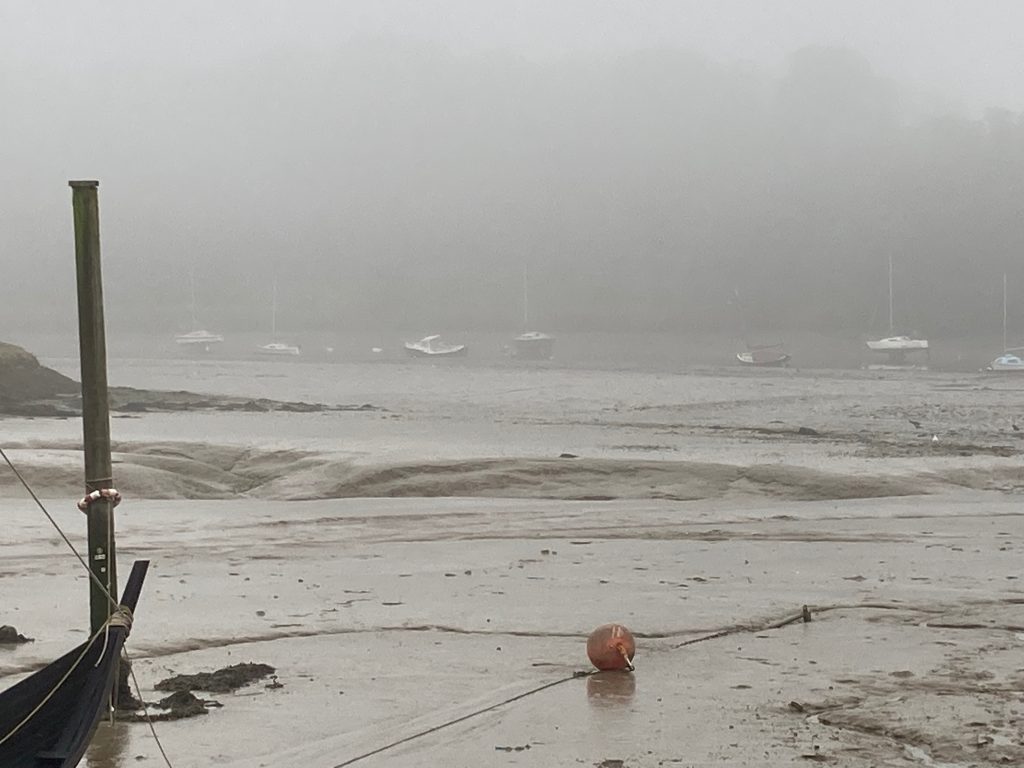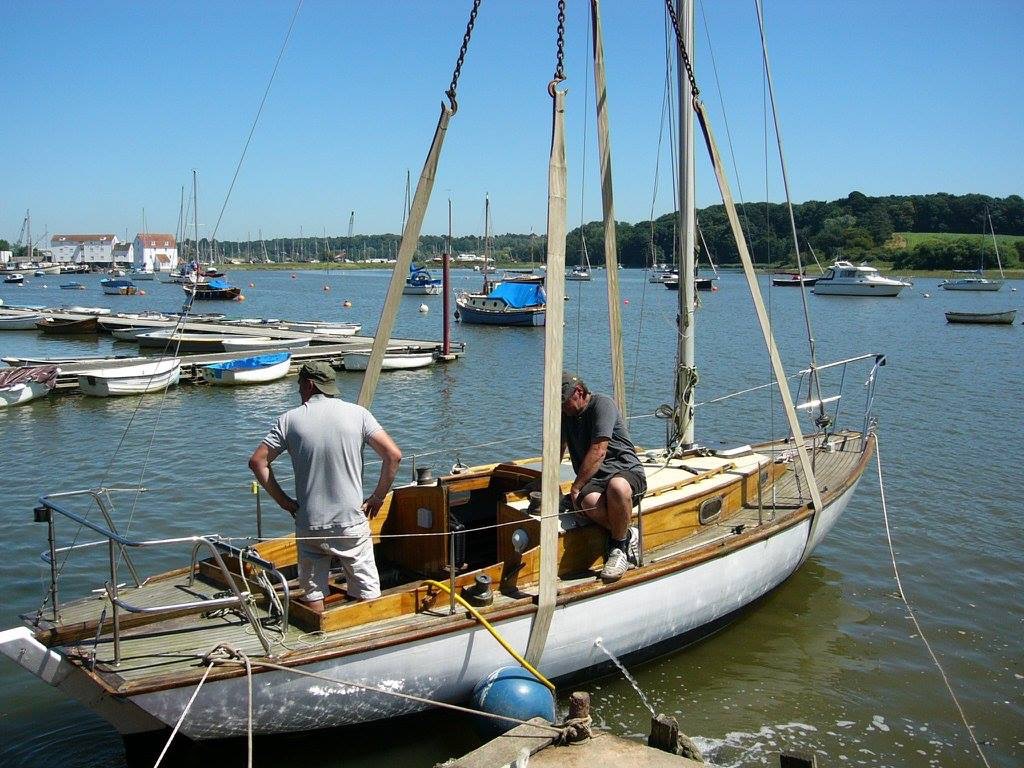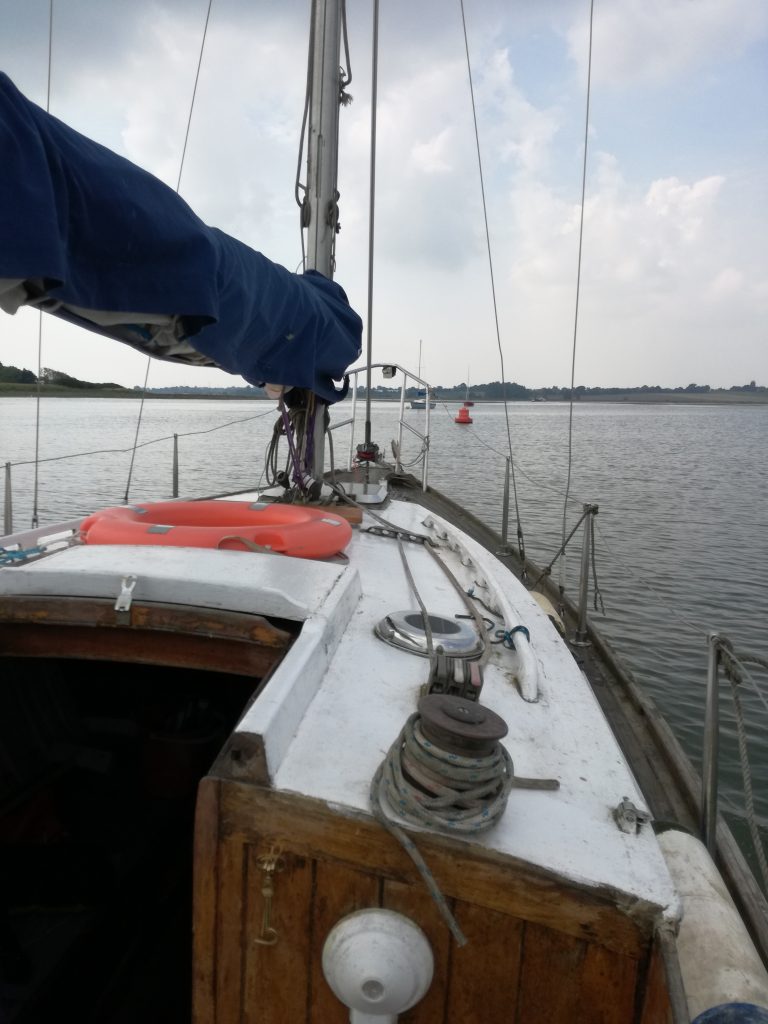
Winter is coming.
It really is. There were storms at the weekend, with seaweed blown all over Whisstocks yard. The weekend before the Longshed was flooded, interrupting the work of recreating the ship buried at Sutton Hoo. There was a very high tide and the flood barriers swung shut, but either the water seeped underneath or the holding tank was full or the drain from the holding tank was blocked nobody really knew, but either way all the work on the re-creation of King Raedwald’s ship stopped, assuming it was his ship in the first place.
Monday and Tuesday by contrast have been Force 2 winds, and skies that cleared by ten, but frost on the cars this morning. Not ideal sailing weather, so I went to check the boat over anyway, and to do some basic winter preparations.
The first thing was to make sure the sails were tied to the yards so they literally didn’t flog themselves to death. Someone lost their jib the winter before last when they left their sails to flap for a month. All they had left were rags when they came back to their boat. The second job was to double-up the lines fore and aft. My Drascombe lives on a mooring in Martlesham Creek, tied at both ends to bouys floating in the river. A couple of weeks ago I bought one of those magic mooring sticks at Andy Seedhouse’s used chandlery, to see if they worked and they do, so all the better that I only paid £20 for a used one instead of the £150 figures I’ve seen online. In case you don’t know, it’s a fork with a pivoted bar over the end, with a line tied to one end of the bar. Tie that to the line on your boat you want to go through the ring on top of your mooring buoy, close the bar, push the fork at the ring, then when it’s gone through pull the fork backwards and somehow, like a conjuring trick, you’ve pulled your line through the hoop on the mooring buoy without having to dangle over the side of the boat threading a piece of rope through a moving ring while your boat floats past. Sometimes with un-hilarious consequences. Anyway, played with that for a bit to check the magic was still working. It was.
The next job was to start the engine, for two reasons. I wanted to get all the fuel out of the carburetor as I wasn’t quite sure when I’d be starting it up again, and the best way of getting rid of the fuel in the engine was to run it. But secondly, I wanted to check the fuel can wasn’t leaking anymore. Which it was, out of the junction of the outlet pipe. I’d fitted a new bronze hollow threaded pipe last week, but although that had stopped one leak there was another still going strong. A month ago I lost the better part of £10 of petrol like that, without the boat going anywhere at all. £10 is one thing, but more irritating was the fact that the idea of leaving the petrol can connected onboard was so the boat was ready to go next time I got down to it. Without petrol, it wasn’t. Petrol can back in the dinghy and a trip to the hardware store for some rubber rings and Vaseline.
Next, the cover. I haven’t had the cover fastened on the boat since June, and this year she went into the water the first week of May. It’s now the first week of November, so we’ve had a solid six months of sailing even if we don’t get any more this year. Which I haven’t decided yet. Before I put the cover on though, there’s the bird crap to get rid of. When I was a boy I was told those big, strange-looking black birds, the ones that stand on top of posts with their wings bent outstretched, those are called cormorants and when you grow up you won’t see them any more, because they’ll be extinct.
Well, they aren’t. Not by a long way. There are three main kinds of birds that arse about on my boat when I’m not there. The redshanks and avocets and the sandpipers and egrets leave it alone because they’re too busy wading about on the mud looking for their tea. And yes, I had to look them up to find out their names but they’re all there, all the time. They aren’t the problem. The gulls, the swans and the cormorants are.
Gulls just sit on top of the mast and use it as a hi-rise lavatory. That always falls in the same place, on the thwart at the base of the mast, port side. The swans – you always know when a swan’s been on board, not just by the size of the green pile of droppings but by the massive muddy webbed footprints all over the boat. No swans today. But the cormorants that didn’t go extinct. It’s not just their waste. It’s not just their muddy feet. It’s the way they dismember crabs. I didn’t even know there were crabs in the Deben, but unless they’re flying to Adleburgh deli there definitely are. And they eat them on my boat, so apart from scrubbing away their muddy track marks and the piles of guano I get to pick crab legs out of the gaps in the floorboards as well.
But all done for the day. I think the petrol can is sealing now. There are two lines at the bow and two lines at the stern, holding the boat snug against any gale. The PVC cover is on tight, held up to two peaks by a line strung between the masts. The sails are lashed tight to the yards. There’s a line of algae growth on the hullmaking a mockery of the words ‘anti-foul,’ but there is on every other boat on this river, whatever your boat and whatever brand of antifoul anyone’s used. I’ve paid for the mooring up to the 5th December and maybe, I told my loyal and trusty crew today, she needs to come out of the water then so I can blast away the algae, repaint the hull and maybe fix those hairline cracks in the gel-coat on the deck. Or just paint it, I was told.
I can’t recall how long into the winter we used to sail at school and somehow, although it was about four million years ago, it seems to matter. There won’t always be another sailing season. There won’t be another forty of them ahead, as there were at school. But it’s all snugged down tight and survivable onboard, safe against the winter winds. In six weeks it’ll start to get lighter in the evenings again, quicker than you’ll think possible. All you have to do is stay warm and remember winter goes away. It’s all ok for now.




